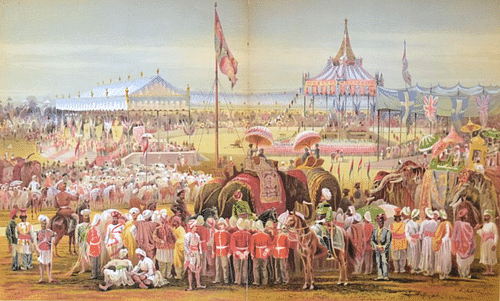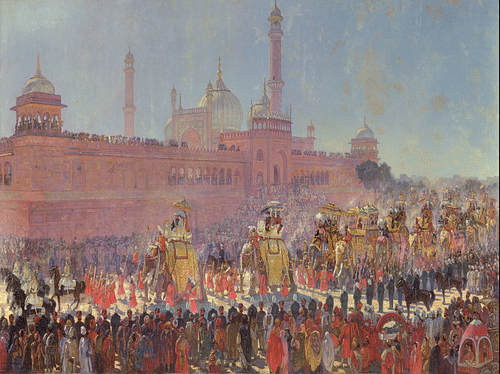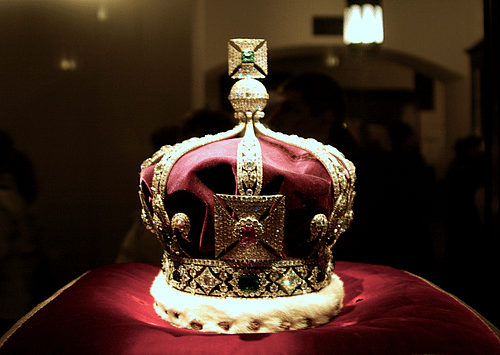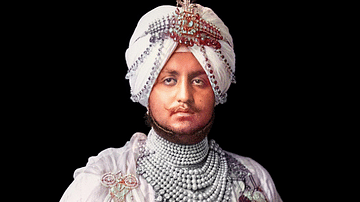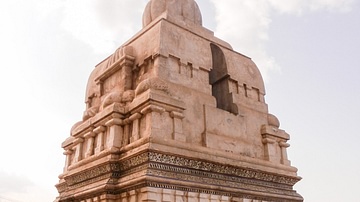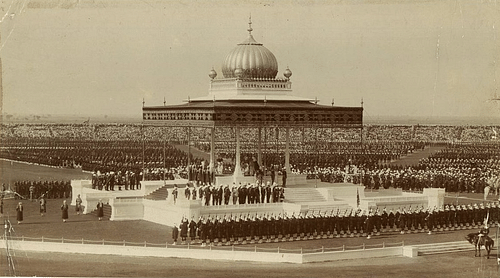
The Delhi Durbar was a spectacular public event held in India to commemorate the accession of a new British monarch to the title Empress or Emperor of India. Three Delhi Durbars were held: 1877, 1903, and 1911. The event involved military processions, elephants, and magnificent carriages, as well as a host of rulers of the Indian princely states paying homage to the British Crown in recognition of its sovereignty over large parts of the subcontinent.
Queen Victoria (r. 1837-1901) did not attend the 1877 Delhi Durbar in person but was represented by the viceroy. Similarly, in the 1903 durbar, another viceroy represented King Edward VII (r. 1900-1910). The 1911 durbar was the most spectacular of all as King George V (r. 1910-1936) attended the event in person.
The Durbar Tradition
Spectacular gatherings of semi-independent or vassal rulers in order to pay homage to an emperor were a regular feature of the Mughal Empire (1526-1857) in India. These ceremonies were held at the royal court or durbar, and so that name became associated with the public act of homage performed by vassal rulers. In the royal palace in Delhi (today known as the Red Fort), the multitude of subordinate rulers gathered in a great open courtyard festooned with coloured awnings and wall hangings while, in the centre, the Mughal emperor awaited their homage of loyalty. The emperor sat majestically on the Peacock Throne, "a stunning construction of gold and jewels surmounted by a golden arch and topped by two gilded peacocks, birds of allegedly incorruptible flesh which may have symbolised not only the splendour of the Mughals but also their durability" (James, 4). The Mughal durbars not only displayed the emperor's power and his subject's obedience but were also an occasion to hear opinions from experienced rulers, to catch up on events in the far corners of the empire, and to settle any disputes or matters of justice between vassal rulers.
The British took on this double idea of power display and receiving homage from allied rulers. Delhi, the capital of the Mughal Empire in India, seemed a suitable location as it would involve a strong propaganda message "of complete British assumption of the symbolic and real power once held by the Mughal emperors" (Barrow, 126). Calcutta (Kolkata) was the other choice since this had long been the main centre of the East India Company, whose territories the British Crown and government took over in 1858. Calcutta was also made the capital of the British Raj (rule) in India. In 1911, however, Delhi replaced Calcutta in this role. For the durbars, though, Delhi was the choice for all three events. To demonstrate to the Indian rulers just why they were paying homage to the British Crown, the British version of the durbar involved a huge display of the empire's military might.
The 1877 Delhi Durbar
Queen Victoria took her place on the British throne in 1837, and so the first Delhi Durbar marked not her accession but, rather, her majesty being proclaimed Empress of India on 1 January 1877. The queen became an empress to demonstrate she was above the various rulers of the semi-independent Indian princely states across the subcontinent that had been conquered by force or become allies within the British Empire. The empress had promised in a proclamation to the Indian princes on 1 November 1858 that
We shall respect the rights, dignity and honour of native princes as our own and we desire that they…should enjoy that prosperity and that social advancement…secured by internal peace and good government.
(Dalziel, 78)
Further, the empress promised that no Indian would be "molested or disquieted, by reason of their religious faith" (Barrow, 126).
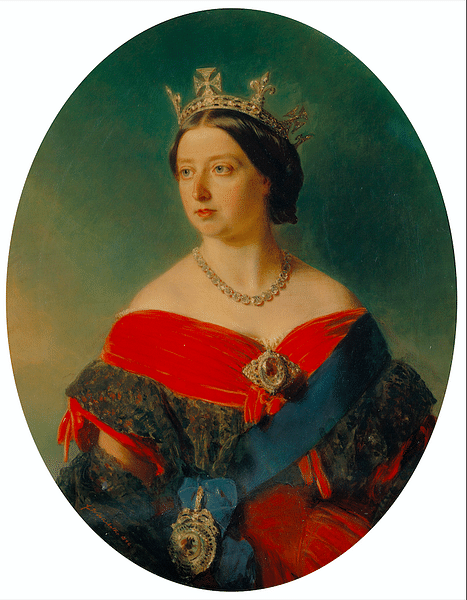
Queen Victoria was 58 at the time and already living a semi-reclusive life in her home kingdoms so that is was no surprise that she did not attend the durbar in person. The empress was officially represented by the viceroy, the 1st Earl of Lytton.
The event was attended by over 400 rulers, including 63 princes. All the princes paraded past to salute the empress' representative, each carrying a silk banner made especially for them for the event. Each prince went by in a carefully selected hierarchy of importance. Many maharajas, rajas, and princes rode by on elephants which carried trappings festooned with jewels. On the British side, the viceroy's platform had a great canopy, the poles of which displayed symbols of Great Britain, such as the cross of Saint George and the Union Jack flag. Hanging over the seated viceroy was a massive gilt-framed portrait of Queen Victoria signed by the empress herself.
The empire's very real military power was displayed in the presence of 15,000 soldiers resplendent in their distinctive red coats. All British officers and dignitaries were dressed in their finest uniforms, rows of medals flashing in the sunlight and plumed hats wavering in the breeze. Another important aim of the durbar was to present the unity of the new India – at least amongst its ruling elite – and in this, it achieved some success, as the Maharaja of Indore noted to the viceroy:
India has been until now a vast heap of stones, some of them small. Now the house is built and from the roof to the basement each stone of it is in its right place.
(James, 316)
The 1903 Delhi Durbar
This durbar was organised on 1 January 1903 to mark the accession to the throne of Edward VII, the eldest son of Queen Victoria, and so the first Emperor of India. Again, the monarch did not attend in person, probably because Edward was then 62. The emperor was officially represented by Viceroy Lord Curzon (in office 1899-1905). Curzon was a great believer in the power of pageantry, and so this durbar was even more spectacular than its predecessor.
The viceroy and his wife, Lady Mary, rode through the centre of Delhi to their shaded viewing platform at the head of a long procession of elephants. The magnificently decorated animals carried other dignitaries such as the Duke and Duchess of Connaught around the perimeter of Delhi's magnificent Red Fort to arrive at a large open space. As the emperor's representative, Curzon travelled in a golden howdah on his elephant, shaded from the sun by a great golden parasol. Once the viceroy reached his seat on the platform he received the royal salute from a huge procession of British soldiers, which included sepoy (Indian) troops such as "the Indian cavalry men - big, bearded soldiers carrying pennoned lances and wearing ochre, green and blue tunics and brightly coloured cummerbunds and turbans" (James, 317).
Curzon wanted to present continuity between India's past and the present British India, and so he included in the durbar many historical elements. There were displays of precious goods made in India such as fine carpets, gemstones, gold and silverware, and fine paintings. All of these demonstrations and processions were largely held in silence, perhaps indicative that Curzon was really staging the affair for the benefit of viewers of photographs and silent films. An aid to those capturing the event on film was the new system of electric lights the viceroy had had installed.
The film reels of the durbar – the first filmed event in the subcontinent – were shown in cinemas in Britain and across India as part of news intervals between feature films. The durbar no doubt helped to convince the public that the British Raj was a rule through consent and mutual esteem, even if this was far from being the whole picture of colonial rule in India.
There were critics of the whole event who saw no real purpose to the pageantry. Some critics thought Curzon had conspired the whole thing to make himself seem more important, terming the durbar not as a festival for a coronation but a 'curzonation'. A known lover of formalities and etiquette, Curzon was perhaps an unfair target. After all, he was "the first viceroy not to possess an elephant, and he needed to borrow one from a maharaja for the durbar" (Gilmour, 151). The high costs of the durbar were another target with many Indian commentators noting the stark contrast between this flamboyant display of wealth and the terrible famine that India had suffered just two years before.
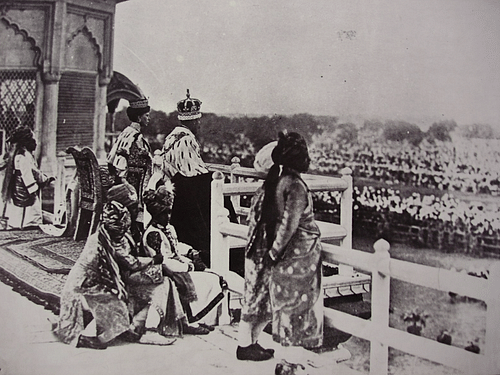
The 1911 Delhi Durbar
This durbar was held on 12 December 1911 and was even more spectacular than its predecessors since, for the first time, the emperor was present in person. King George V and Queen Mary of Teck's presence did create something of a problem for the organisers. A statute law prohibited taking the British Crown Jewels out of the home kingdoms and so a purpose-built crown was needed for the ceremony in Delhi. The Imperial Crown of India has eight half-arches and contains many jewels from India itself, with stand-out stones being the square emerald in the top cross. It has an incredible 6,002 diamonds and other gems studded around it. The crown has only ever been worn once and today resides in the Tower of London.
Perhaps to ensure goodwill and, more importantly, good attendance, many Indian rulers were awarded all manner of titles and membership to knightly orders prior to the big event. Such medals and awards could then be worn with pride in the usual procession of homage to the British Crown. The king and queen sat on a raised scarlet platform complete with a golden awning. The royal pair were resplendent in their purple and ermine robes and bejewelled crowns, visible to all of the 100,000 spectators at the event. Speeches were read out in English and Urdu and, after a royal cannon salute, some 30,000 troops paraded past their monarch. George V was delighted with the durbar and described it as "the most wonderful and beautiful sight I ever saw" (McKernan, 130).
The 1911 durbar was also the occasion to announce two important administrative changes. The first announcement was the reversal of the controversial policy to partition Bengal and the second was the official change of capital from Calcutta to Delhi.
There was one hiccup, and it involved Sayagi Rao, the Gaikwar of Baroda. This ruler had not been given a knighthood in the recent honours list, most likely because of his outspoken views on Indian independence. The gaikwar was, though, loyal to the emperor and had just donated a massive 35,000 rupees to the British Raj. The rather peeved gaikwar decided to show his disaffection by approaching the royal platform and bowing only once before the emperor, and that a very short and sharp inclination of the head. Three bows were performed by everyone else, and not only was Sayagi Rao's gesture immediately noted by those present but it was also captured by those filming the durbar to be shown in newsreels in British cinemas. As news clips, a coloured film, and magic lantern slide shows satiated the great public interest in the durbar, the incident sounded an awkward note in the otherwise flawless symphony of accord the British had wished to present to the world in their carefully orchestrated pageantry.
